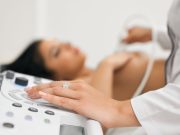Tag: Mammography
DBT Increases Cancer Detection Versus Digital Mammography
Lower proportion of advanced cancer seen with digital breast tomosynthesis than with DM
Breast Arterial Calcifications May Be Marker for Future Heart Disease
Authors say breast arterial calcifications identified on mammogram should be routinely reported
Likelihood of Return for Screening Low After False-Positive Mammogram
Women more likely to return for additional imaging only, short-interval follow-up, or biopsy after true-negative result
Patients Have to Travel Farther for Facilities With Breast MRI, Ultrasound Than for Mammography
Associations seen for Area Deprivation Index and urbanicity with distance to nearest breast imaging facility
Some Women in Their 40s Prefer to Delay Breast Cancer Screening
27.0 percent preferred to delay screening before viewing decision aid compared with 38.5 percent after decision aid
AI Cuts Radiologists’ Workload in Mammography Screening
Screening performance increased following AI implementation
Pandemic Had Temporary Negative Effect on Breast Cancer Screening
However, prolonged negative effect was seen on follow-up screening
Patient Characteristics Linked to Performance of AI Algorithm for DBT
Patient characteristics linked to AI algorithm performance when analyzing negative screening digital breast tomosynthesis mammograms
Text Message Outreach Can Help Increase Mammogram Completion Rates
Text messaging after initial outreach for breast cancer screening increases completion of mammograms
USPSTF Recommends Breast Cancer Screening for Women Aged 40 to 75 Years
Insufficient evidence seen for screening older women and for supplemental screening for women with dense breasts














